Bagpuss
Member
After reading [ame="http://www.derelictplaces.co.uk/main/showthread.php?t=16668"]Bonniemcprice's report[/ame] from last year, this farmhouse also really took hold of me and I was determined to visit it when we were next over in Wales. Unfortunately me and the missus picked the wrong day to go weather-wise - a combination of fine misty drizzle and steady winds resulted in dark and often blurry photos - however it did make the visit a bit more atmospheric.
There is little history to be found about the farm or it's last owner. Bonniemcprice discovered in [ame="http://www.derelictplaces.co.uk/main/showthread.php?t=18706"]her last visit[/ame] that the farmer was a wealthy eccentric who died two years ago with no heirs. In late 2009 planning permission was denied to convert the three main outbuildings into houses. The reasons given are that the barn is too close to the farmhouse, the coach house is in such a state of disrepair that renovation would be considered a new build, and renovating the milking parlour would not have been of a high enough standard for living accommodation and so would also have to be a new build. Additionally, the access road to the farm joins the main road at an angle, making it a hazard to enter the road, and difficult to gain access when coming from the opposite direction. I must admit, on leaving I had a hell of a job reversing my car back onto the road and then turning around (though it was muddy and my steering wheel is on the wrong side ).
).
The farm is for sale at a price of £350,000, including at least 70 acres of land. But despite the wonderful views and good placement (you have such a secluded feeling despite being within a few minutes drive away from the centre of Pontypridd), it is clearly worth nowhere near that, and is at risk of sitting dormant for many more years, succumbing to the elements and the thieving scum who insist on ripping the heart out of the place.
We bumped into a jolly Scotman while we were here, who turned out to be a surveyor who was working on behalf of a client who is interested in buying. He hadn't been there long and appeared to be trying to pluck up the courage to go in. Inbetween snapping on his camera and writing notes, he was more than happy to talk, giving his opinion on the state of the place and explaining how he came to his conclusions. He showed me the side of the house, which had a very visible dark line snaking down from the roof to the base, suggesting problems with the chimney. He pointed out the dry rot that was in every room - like large shiitake mushrooms sprouting from the walls. He said that in his eyes, the place was pretty worthless as renovation would cost another £350k, and so he'd recommend that the price is lowered and that everything should be demolished. I asked him if it was the worst property he had ever seen, and he thought for a moment and said that it was not the worst, but certainly up there.
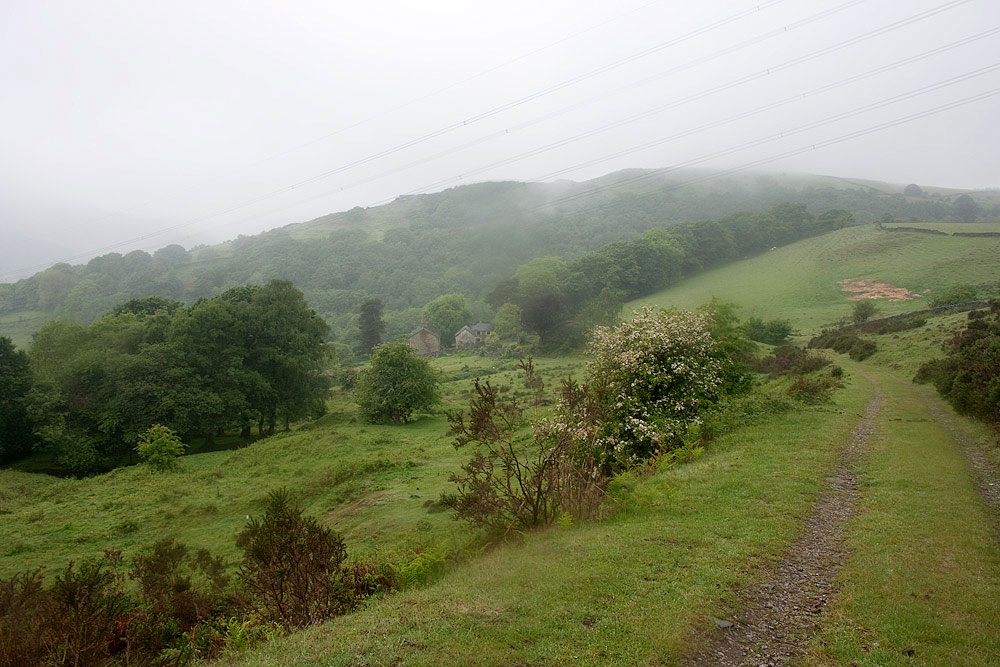
The track between the road and the farmhouse is approx 400 metres long and drops downhill by about 45 metres. It is becoming a bit of a dumping ground, with all kinds of random objects strewn across the track and, to a certain extent, into the surrounding fields. Overhead the powerlines span from enormous pylons, which emit a loud buzzing noise (presumably only when it's wet).
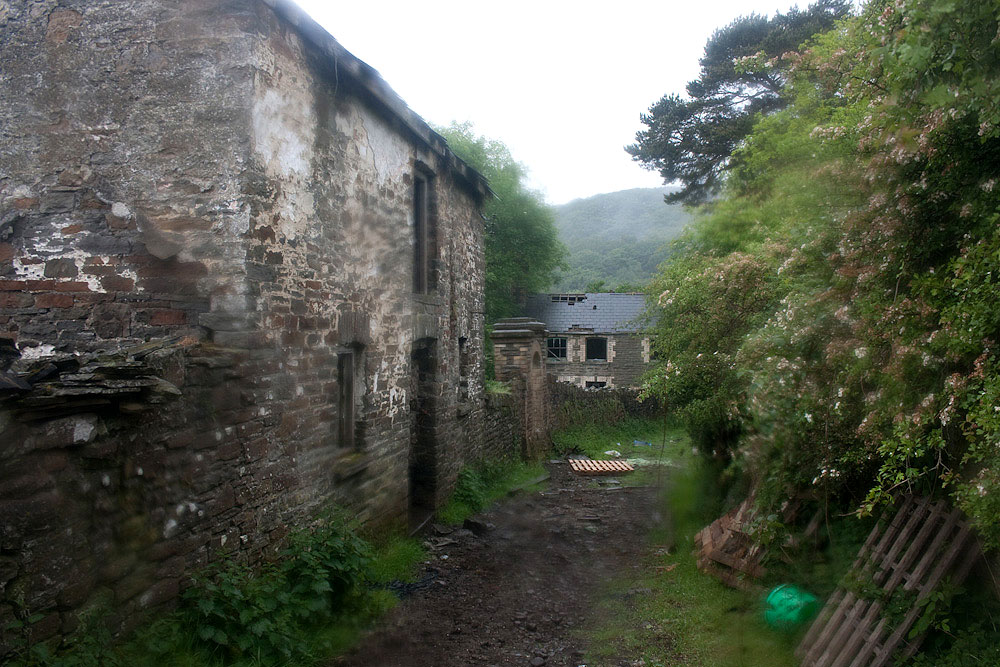
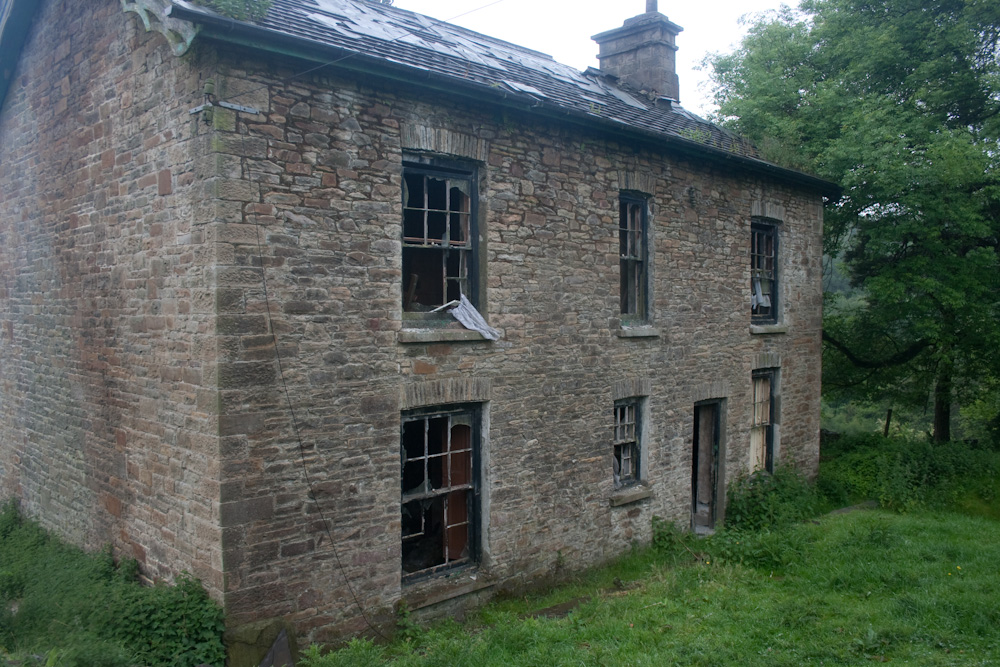
The rear of the farmhouse. Not a single pane of glass has survived and most of the slate from the roof is missing.
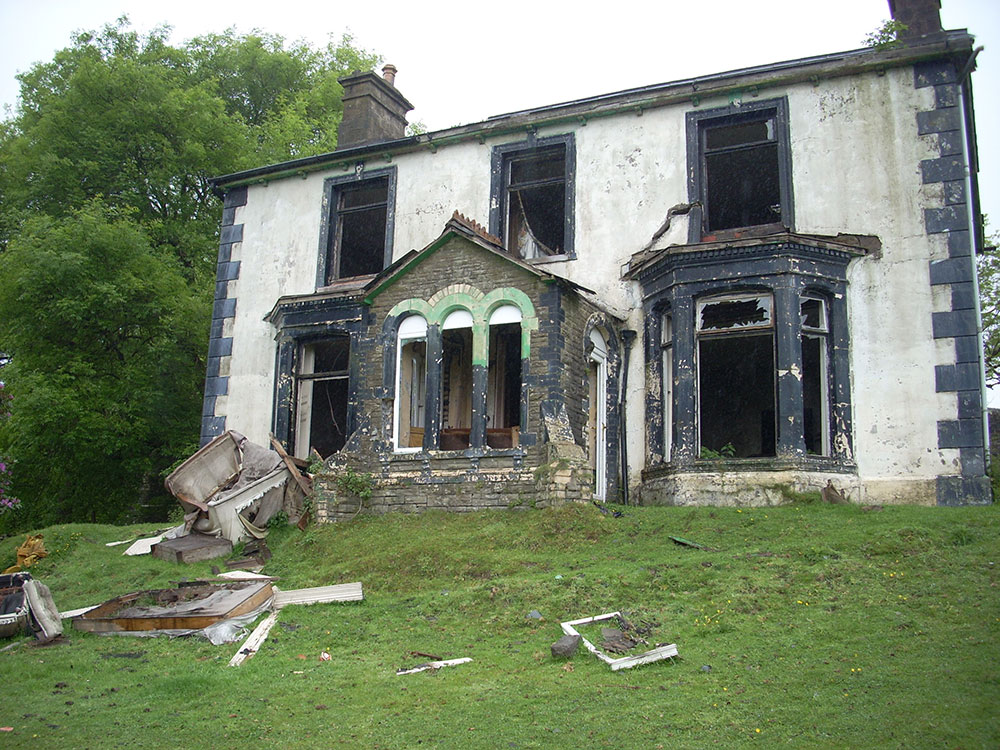
The front of the farmhouse. Furniture has been thrown out onto the lawn, and partially set on fire. Some of the stuff is probably antique. It has come from the left front room, which has been completely stripped of the floorboards.
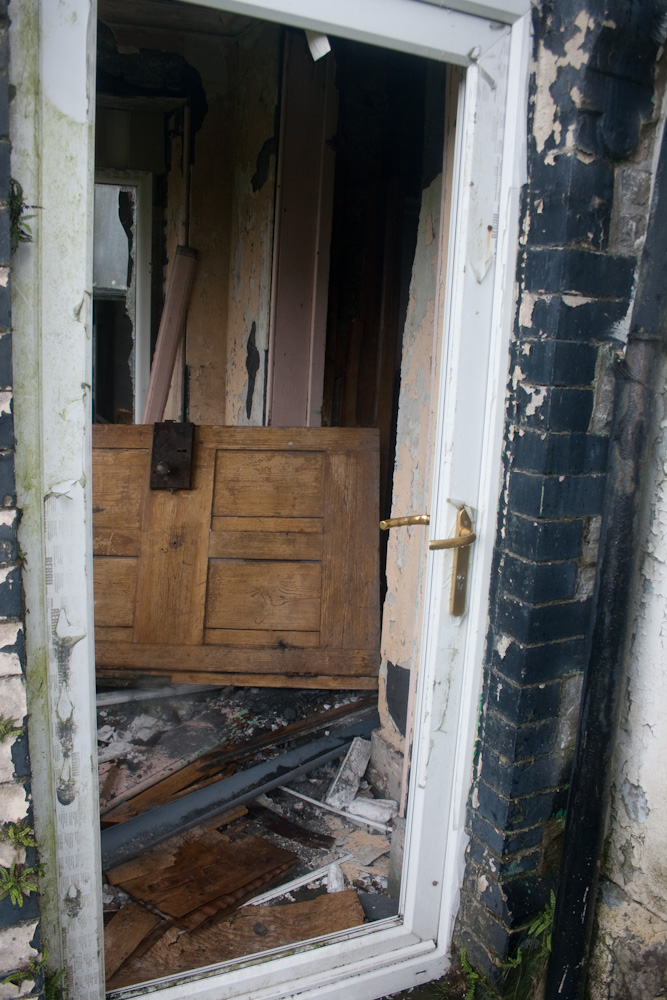
The 'porch' has had brand new uPVC door and windows fitted - so new even the protective film was still in place - but all the glass has been smashed out.
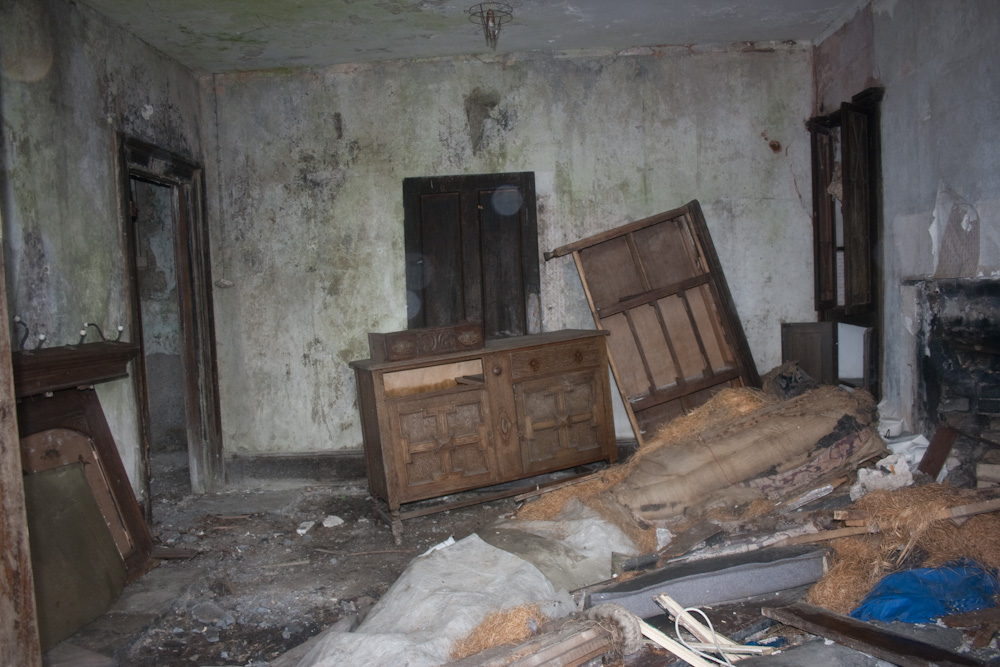
The right front room.
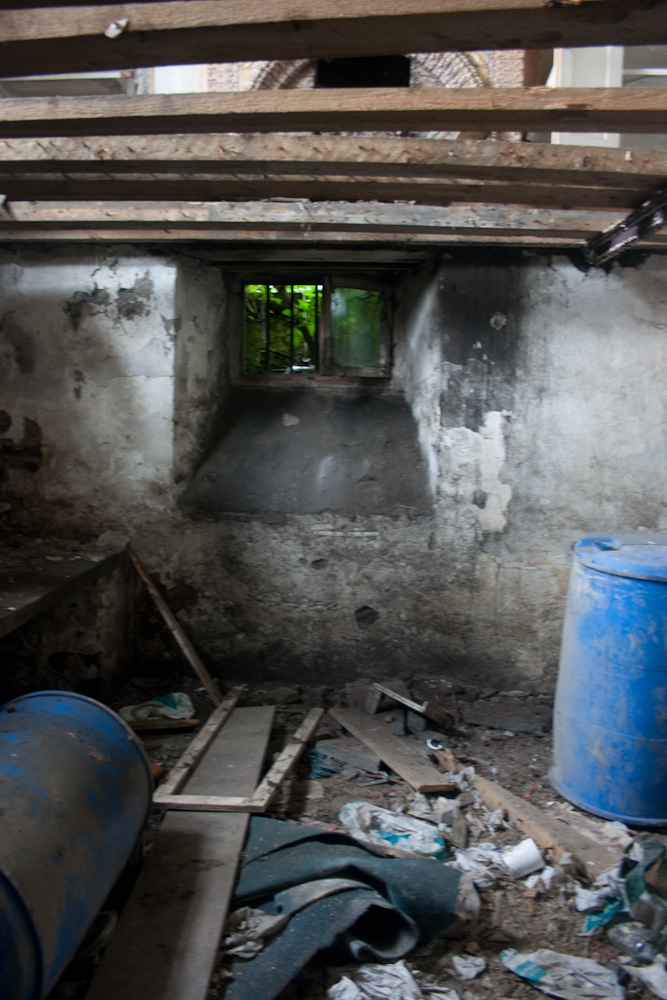
The cellar (underneath what I referred to as the 'left front room'). This room has probably never received so much natural light.
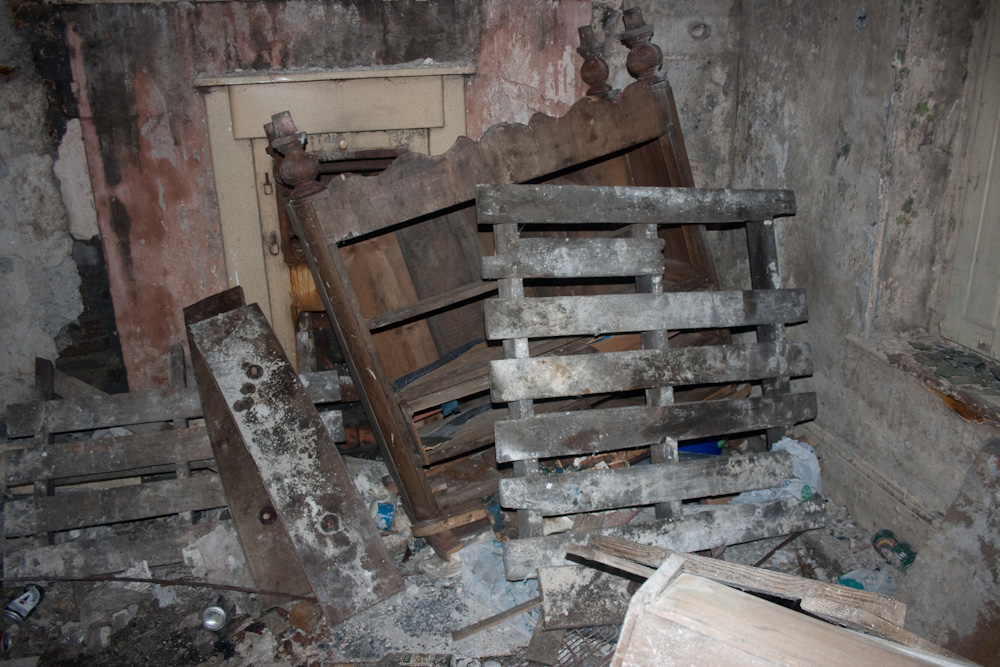
The back room. There was half a fridge in here as well as a back door, and was next to a larder, so I assume that this was a kitchen area.
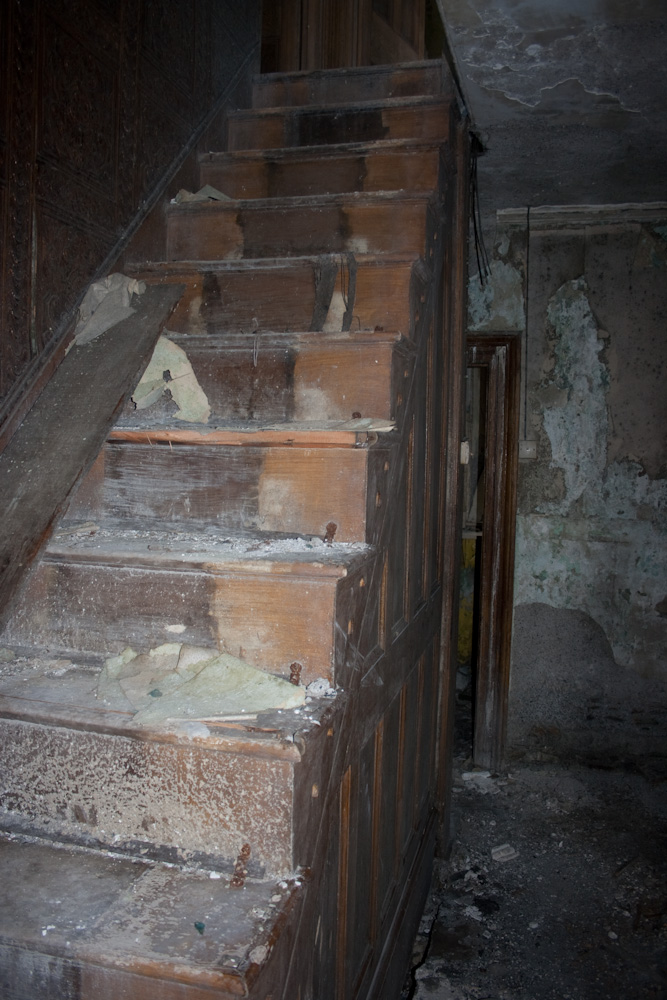
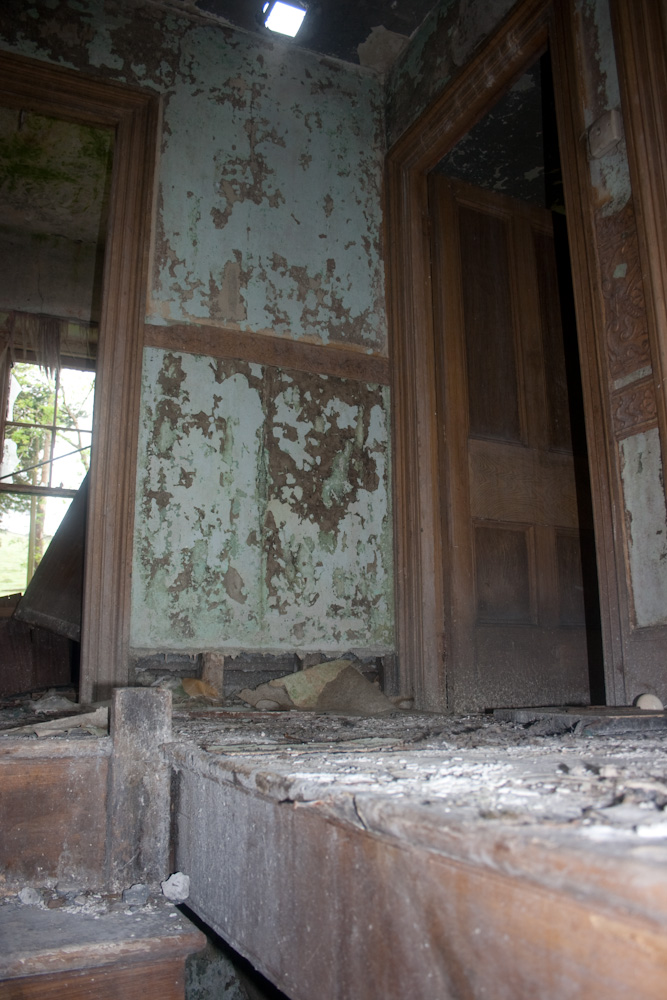
We tested the stairs and decided it was safe to continue. The bottom step and the floor around the base of the stairs are very dodgy. Upstairs the floors are not great, and it will take a brave soul to go completely into the bedrooms as the sky is visible through the ceilings.
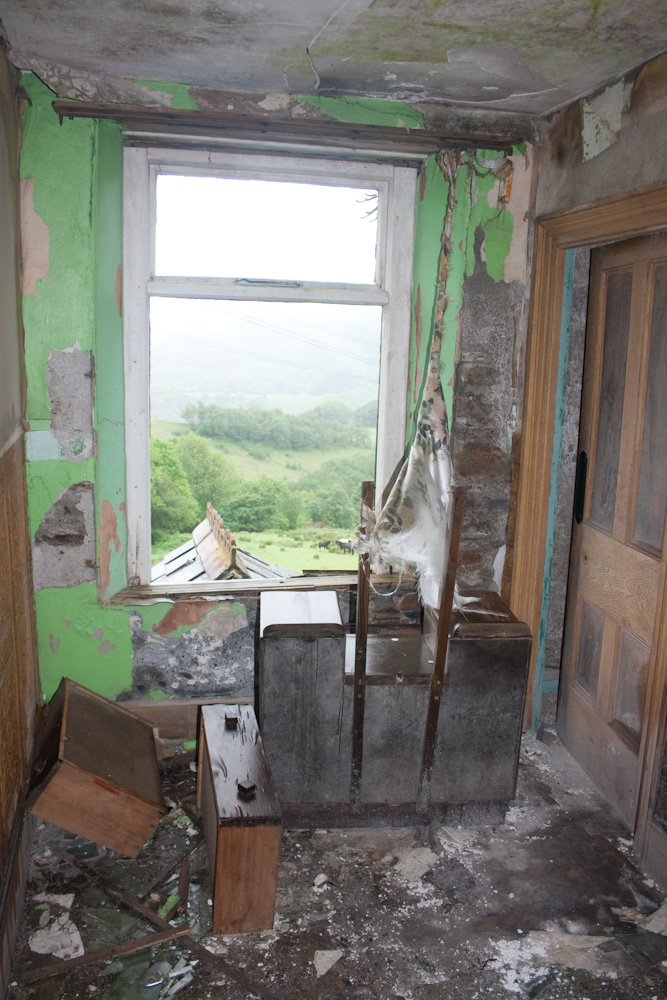
This is the room with the enormous crack that you can see at the front of the house. The window frame is no longer supported at the bottom.
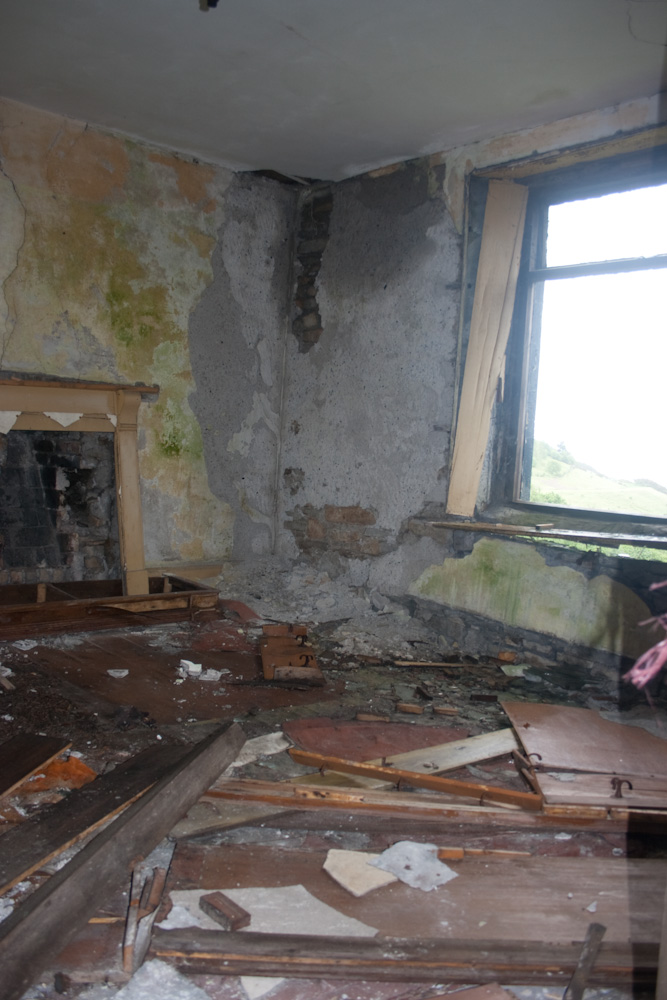
There is a horrendous smell upstairs. The surveyor said that it was dry rot, but to me it was stronger than that. I went into one of the bedrooms and found the 'infamous' bed. Presumably made of straw or animal hair or something, it is now utterly rancid and covered in guano and godknows what else.
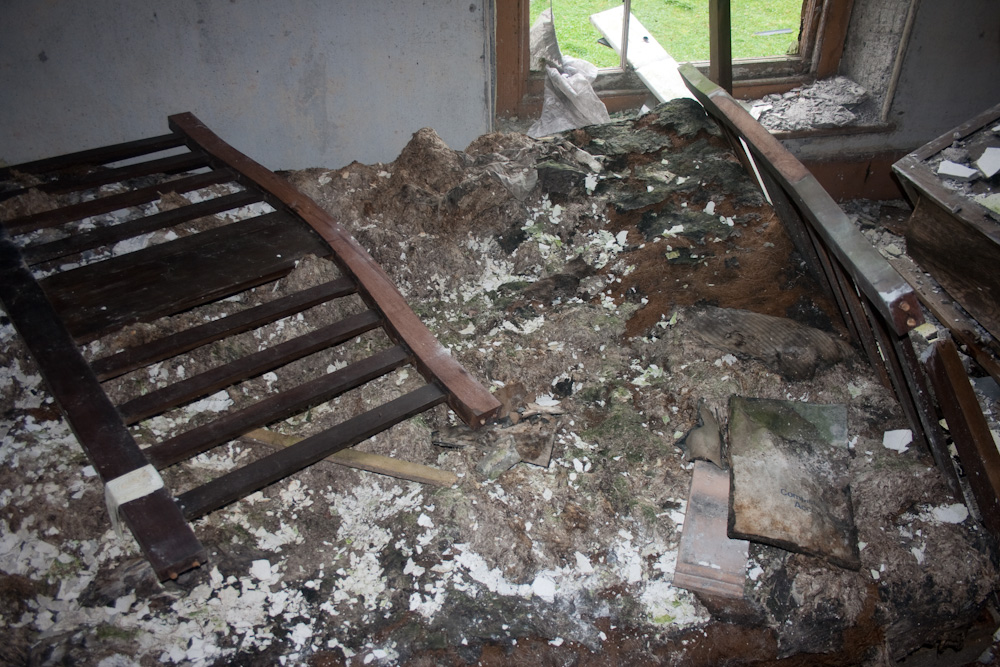
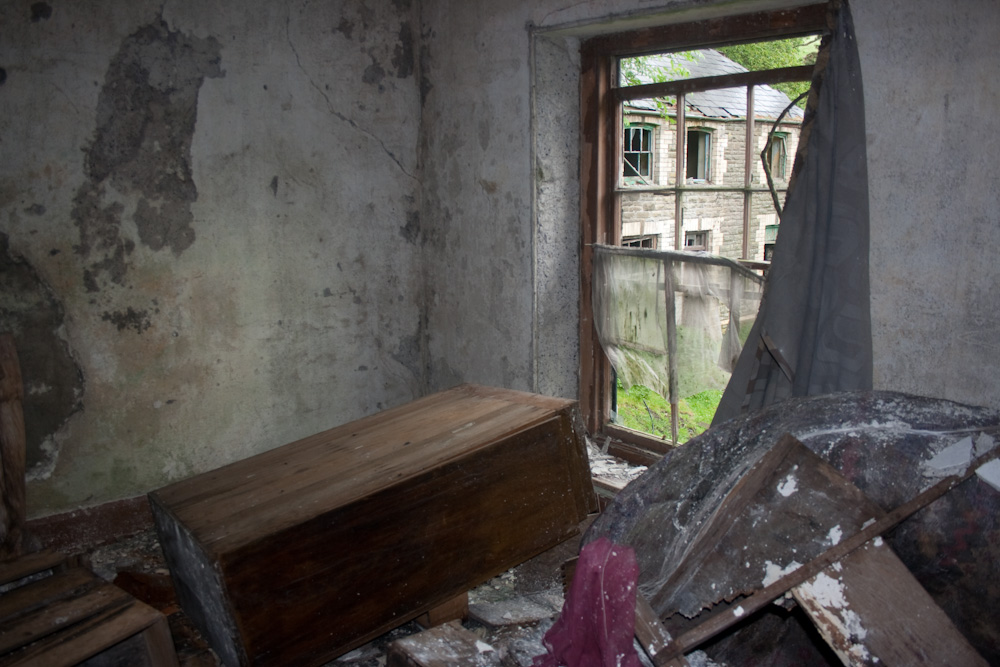

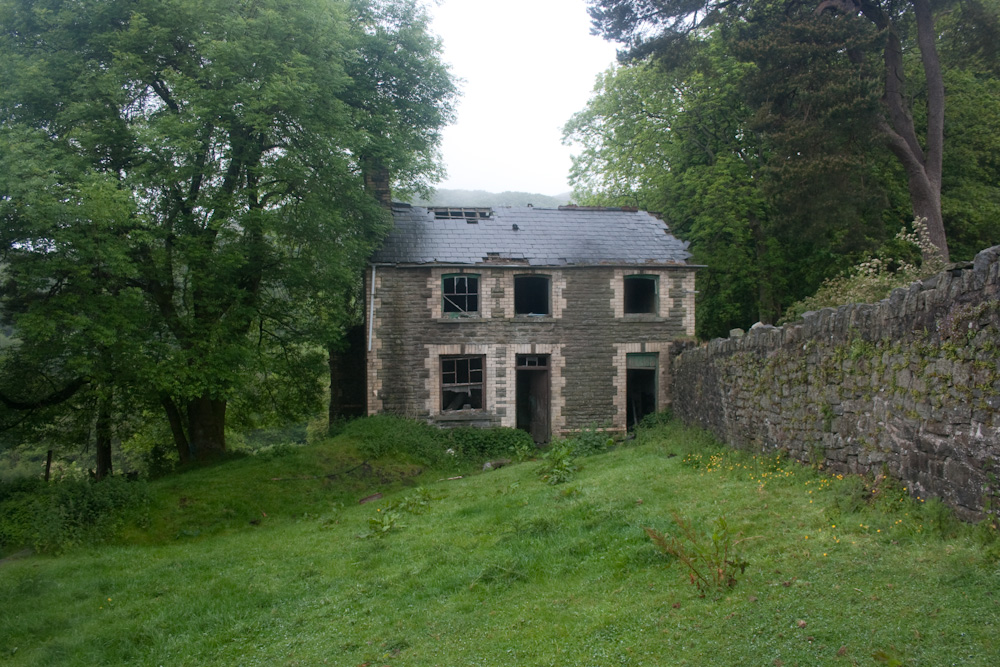
The coach house was probably derelict while the owner lived here, and was probably just used for storage. Downstairs is full of bags of decaying wool. Neither me or the surveyor felt that it was safe to attempt to go upstairs as the stairs felt very spongy. The rear half of the building has virtually disappeared, and looking at Google Maps it appears to have been this way for some time. The surveyor mentioned that he had seen a report saying that it was 'structurally sound', so he was a bit surprised to find it now in this state.
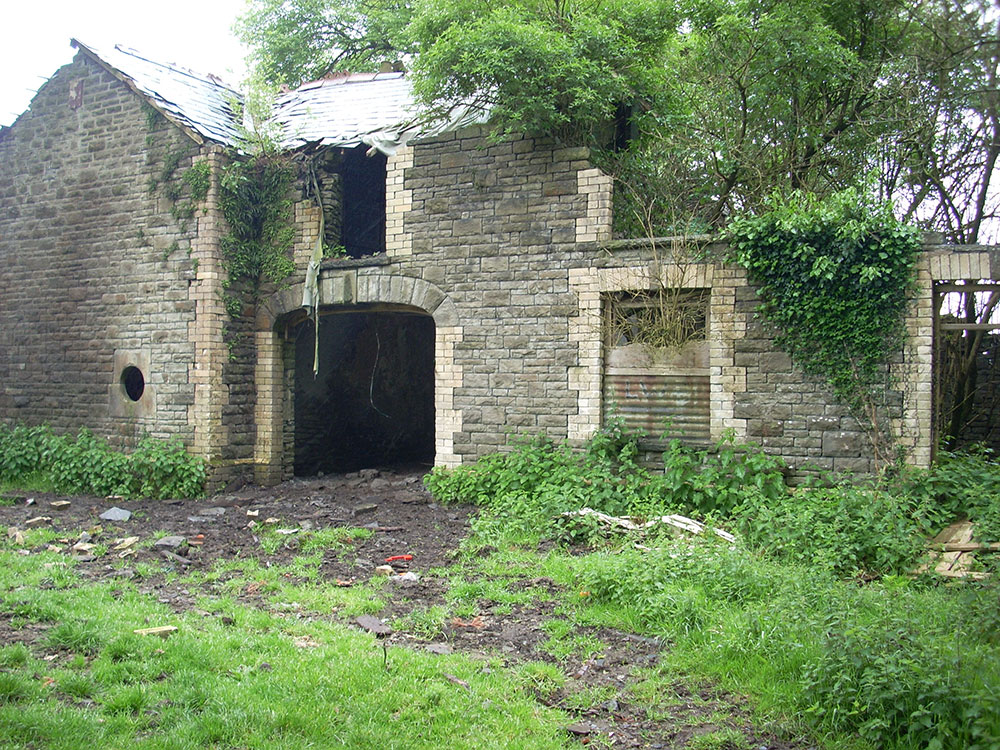
We can only imagine that this red brick building is the milking parlour. It has collapsed only recently - on the estate agent's website, it was shown as whole, but they removed the picture after they realised that the building was no more. I am wondering if perhaps a tree fell on it during a storm (though if that was the case, the tree has now been removed).
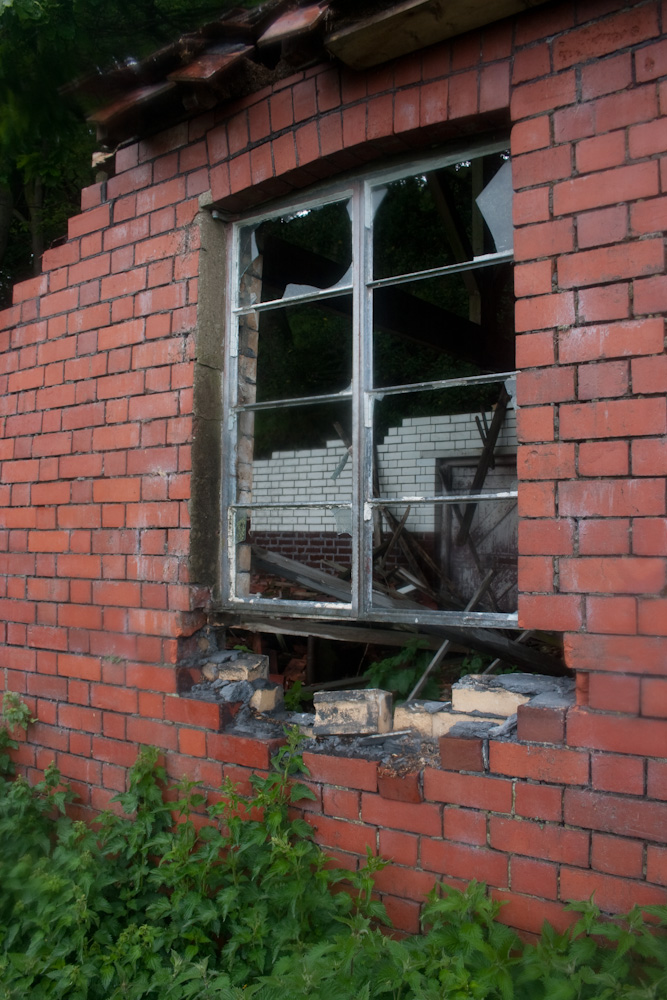
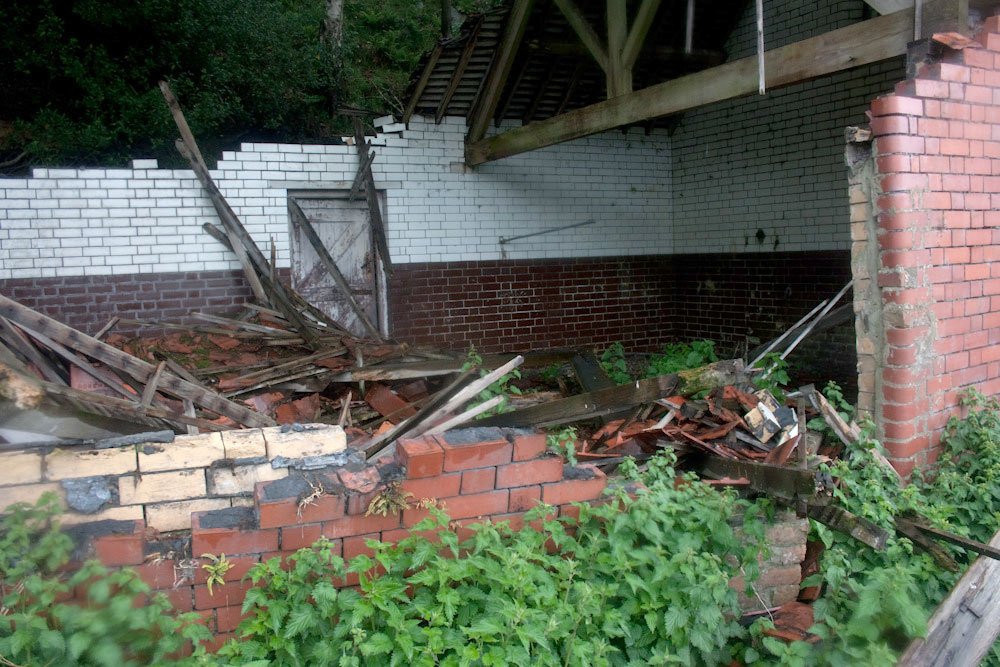
Littered around the farm track is evidence of idiocy. There are a few luggage bags, including this one (unfortunately not very well pictured) bag that has broken that is has slate falling out of it. I guess that some thieving gits come up the farm and load up the bags with slate, and this one broke before they could make their escape.
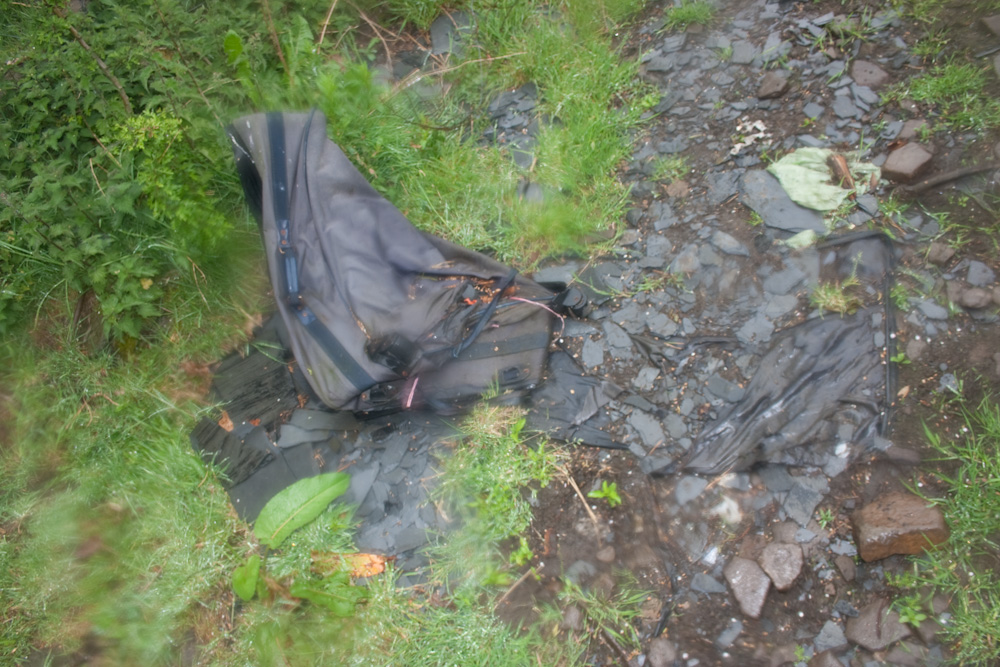
Older photos of the coach house and Google Maps show a white Ford Escort van outside. Since then the van has disappeared, but there are bits of it strewn all over the place. By the milking parlour are the seats and the ceiling liner, and further up are teh remains of it's horn, indicator and badge.
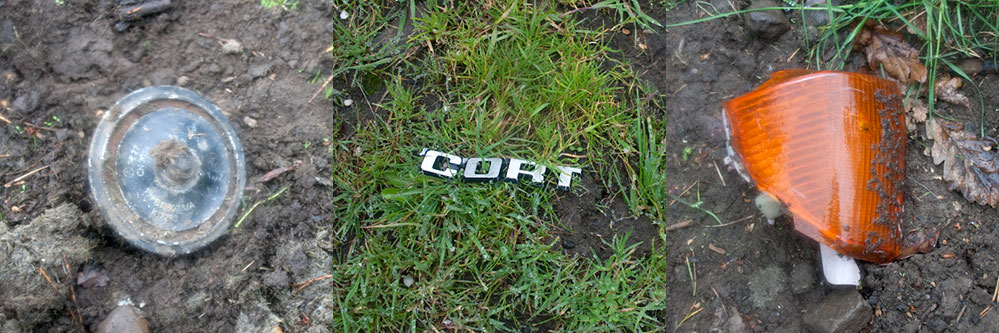
All around the lower parts of the farm were these bizarre lumps in the grass. They are like molehills, but the moles would have to be enormous to make these kinds of hills. Anyone got a clue what they are?
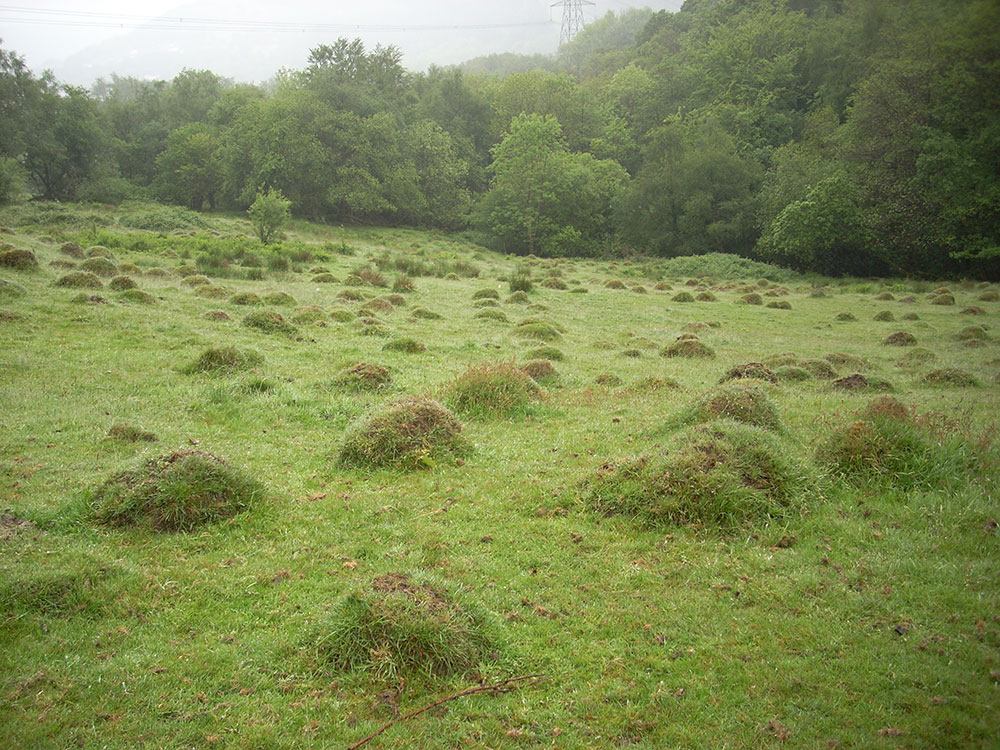
The final picture is the view that would have been enjoyed from the landing of the farmhouse. I love this place and I really think it deserves saving, but unfortunately even a lottery winner might struggle to spend this sort of their windfall on what is effectively a plot of farmland.
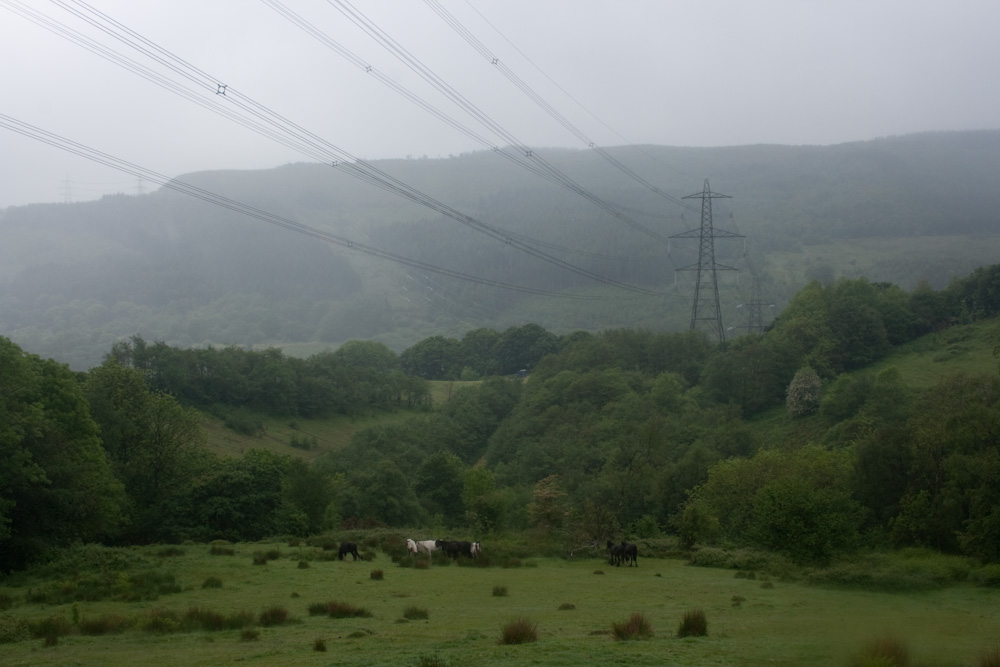
There is little history to be found about the farm or it's last owner. Bonniemcprice discovered in [ame="http://www.derelictplaces.co.uk/main/showthread.php?t=18706"]her last visit[/ame] that the farmer was a wealthy eccentric who died two years ago with no heirs. In late 2009 planning permission was denied to convert the three main outbuildings into houses. The reasons given are that the barn is too close to the farmhouse, the coach house is in such a state of disrepair that renovation would be considered a new build, and renovating the milking parlour would not have been of a high enough standard for living accommodation and so would also have to be a new build. Additionally, the access road to the farm joins the main road at an angle, making it a hazard to enter the road, and difficult to gain access when coming from the opposite direction. I must admit, on leaving I had a hell of a job reversing my car back onto the road and then turning around (though it was muddy and my steering wheel is on the wrong side
The farm is for sale at a price of £350,000, including at least 70 acres of land. But despite the wonderful views and good placement (you have such a secluded feeling despite being within a few minutes drive away from the centre of Pontypridd), it is clearly worth nowhere near that, and is at risk of sitting dormant for many more years, succumbing to the elements and the thieving scum who insist on ripping the heart out of the place.
We bumped into a jolly Scotman while we were here, who turned out to be a surveyor who was working on behalf of a client who is interested in buying. He hadn't been there long and appeared to be trying to pluck up the courage to go in. Inbetween snapping on his camera and writing notes, he was more than happy to talk, giving his opinion on the state of the place and explaining how he came to his conclusions. He showed me the side of the house, which had a very visible dark line snaking down from the roof to the base, suggesting problems with the chimney. He pointed out the dry rot that was in every room - like large shiitake mushrooms sprouting from the walls. He said that in his eyes, the place was pretty worthless as renovation would cost another £350k, and so he'd recommend that the price is lowered and that everything should be demolished. I asked him if it was the worst property he had ever seen, and he thought for a moment and said that it was not the worst, but certainly up there.

The track between the road and the farmhouse is approx 400 metres long and drops downhill by about 45 metres. It is becoming a bit of a dumping ground, with all kinds of random objects strewn across the track and, to a certain extent, into the surrounding fields. Overhead the powerlines span from enormous pylons, which emit a loud buzzing noise (presumably only when it's wet).


The rear of the farmhouse. Not a single pane of glass has survived and most of the slate from the roof is missing.

The front of the farmhouse. Furniture has been thrown out onto the lawn, and partially set on fire. Some of the stuff is probably antique. It has come from the left front room, which has been completely stripped of the floorboards.

The 'porch' has had brand new uPVC door and windows fitted - so new even the protective film was still in place - but all the glass has been smashed out.

The right front room.

The cellar (underneath what I referred to as the 'left front room'). This room has probably never received so much natural light.

The back room. There was half a fridge in here as well as a back door, and was next to a larder, so I assume that this was a kitchen area.


We tested the stairs and decided it was safe to continue. The bottom step and the floor around the base of the stairs are very dodgy. Upstairs the floors are not great, and it will take a brave soul to go completely into the bedrooms as the sky is visible through the ceilings.

This is the room with the enormous crack that you can see at the front of the house. The window frame is no longer supported at the bottom.

There is a horrendous smell upstairs. The surveyor said that it was dry rot, but to me it was stronger than that. I went into one of the bedrooms and found the 'infamous' bed. Presumably made of straw or animal hair or something, it is now utterly rancid and covered in guano and godknows what else.




The coach house was probably derelict while the owner lived here, and was probably just used for storage. Downstairs is full of bags of decaying wool. Neither me or the surveyor felt that it was safe to attempt to go upstairs as the stairs felt very spongy. The rear half of the building has virtually disappeared, and looking at Google Maps it appears to have been this way for some time. The surveyor mentioned that he had seen a report saying that it was 'structurally sound', so he was a bit surprised to find it now in this state.

We can only imagine that this red brick building is the milking parlour. It has collapsed only recently - on the estate agent's website, it was shown as whole, but they removed the picture after they realised that the building was no more. I am wondering if perhaps a tree fell on it during a storm (though if that was the case, the tree has now been removed).


Littered around the farm track is evidence of idiocy. There are a few luggage bags, including this one (unfortunately not very well pictured) bag that has broken that is has slate falling out of it. I guess that some thieving gits come up the farm and load up the bags with slate, and this one broke before they could make their escape.

Older photos of the coach house and Google Maps show a white Ford Escort van outside. Since then the van has disappeared, but there are bits of it strewn all over the place. By the milking parlour are the seats and the ceiling liner, and further up are teh remains of it's horn, indicator and badge.

All around the lower parts of the farm were these bizarre lumps in the grass. They are like molehills, but the moles would have to be enormous to make these kinds of hills. Anyone got a clue what they are?

The final picture is the view that would have been enjoyed from the landing of the farmhouse. I love this place and I really think it deserves saving, but unfortunately even a lottery winner might struggle to spend this sort of their windfall on what is effectively a plot of farmland.


































